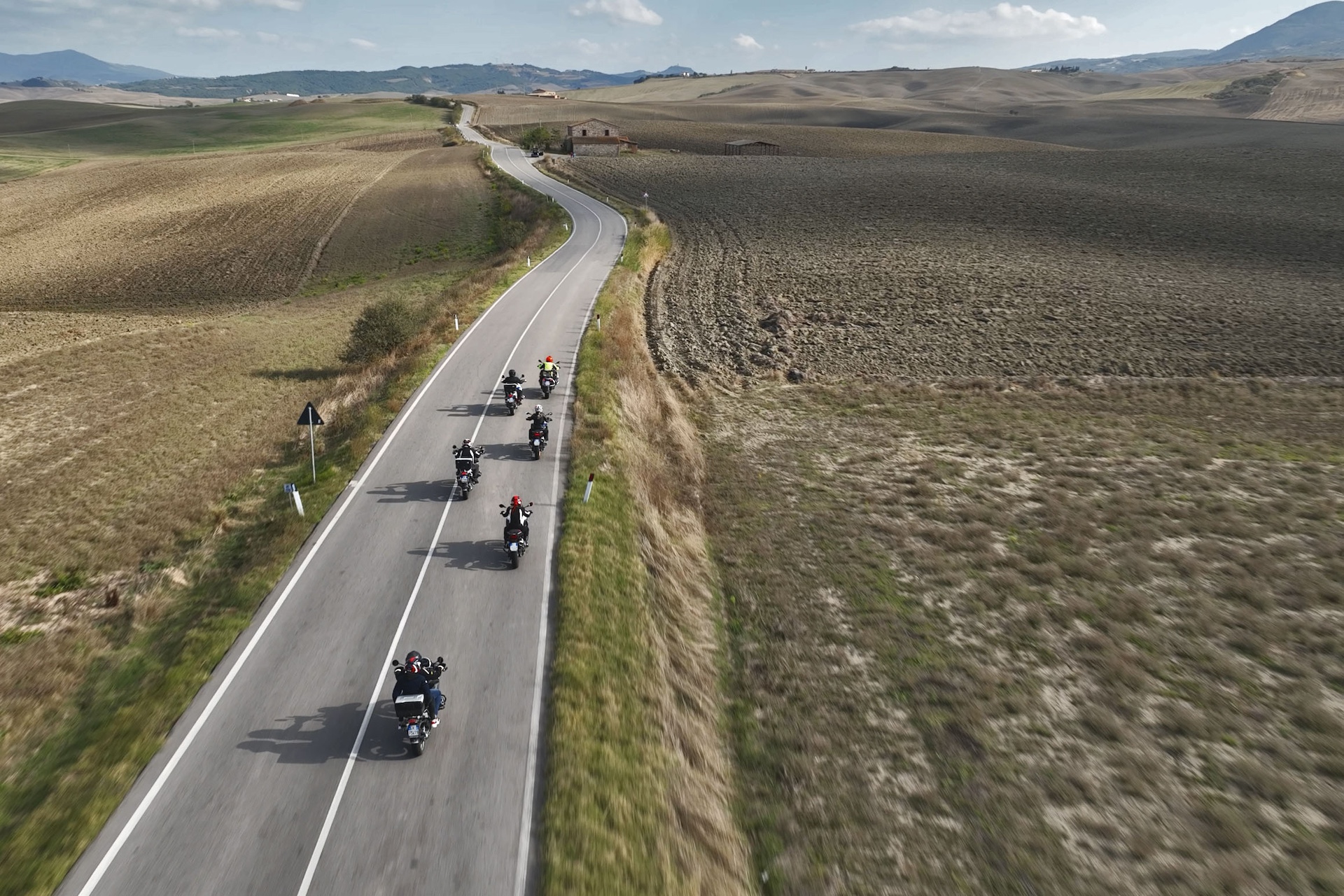A luxury motorcycle tour is more than just a ride—it’s your chance to experience the world from a unique perspective, with every twist of the throttle bringing you closer to freedom and adventure.
But the thrill is only as good as the safety measures you take. Safety isn’t just about avoiding accidents—it’s about riding smarter, feeling more confident, and fully immersing yourself in the journey.
These 17 safety tips aren’t just a checklist—they’re your roadmap to a flawless, memorable tour that blends the excitement of the open road with peace of mind.
Whether you’re cruising through the rolling hills of Tuscany or winding along California’s breathtaking coastline, these insights will ensure you ride like a pro, prepared for every mile ahead.
Explore our premium motorcycle tours in Tuscany and California to kick-start your adventure today!
Preparing for a Luxury Motorcycle Tour
1. Perform a Thorough Motorcycle Inspection
Before heading out, examine your motorcycle for any potential issues. Check tire tread depth (at least 1.6mm is required for safe riding), inspect for cracks or wear, and verify proper inflation. Test your brake system to ensure it responds effectively without any lag or unusual sounds. Inspect all lights, including headlights, brake lights, and turn signals, for full functionality. Assess fluid levels such as engine oil, brake fluid, and coolant, topping them off as needed. Ensure that your mirrors are properly adjusted for maximum visibility.
2. Invest in Quality Riding Gear
Choose gear designed for both protection and comfort. A helmet that meets DOT or ECE safety standards is critical. Select abrasion-resistant jackets and pants, preferably with built-in armor at key impact points such as elbows, knees, and shoulders. Opt for gloves that provide grip and protection against impact. High-quality riding boots should cover your ankles and offer sturdy soles for better bike control. Layer your gear if riding in variable climates to ensure comfort without compromising safety.
3. Plan and Familiarize Yourself with Your Route
Research the planned route thoroughly, including weather conditions, road types, and fuel stops. Note any potential hazards such as construction zones or high-traffic areas. Use GPS navigation but carry a physical map in case of device failure. Mark emergency services, repair shops, and accommodations along the way to avoid surprises.
On the Road: Safety in Motion
4. Practice Defensive Riding
Stay alert to your surroundings and anticipate other drivers’ actions, especially in high-traffic areas or unfamiliar regions. Keep an eye out for blind spots of larger vehicles like trucks. Ride at a safe speed that allows you time to react to sudden changes in traffic or road conditions. Avoid distractions such as mobile devices while riding.
5. Keep Safe Distances
Maintain a safe following distance, ideally three to four seconds behind the vehicle in front. This distance allows enough reaction time in case the vehicle brakes suddenly or swerves. Avoid riding directly behind large vehicles that obstruct your view of the road ahead.
6. Enhance Your Visibility
Wear bright or reflective clothing, even during daylight hours. Equip your motorcycle with additional reflective elements or LED lights to increase visibility in low-light or foggy conditions. Position yourself in the lane where you are most visible to other drivers.
7. Adapt to Weather Conditions
Check the forecast for your route before departure and prepare for sudden changes. Reduce speed, maintain a larger following distance in rainy conditions, and avoid sharp turns. In cold weather, layer up with insulated riding gear. For hot climates, wear ventilated clothing and stay hydrated. If visibility becomes significantly impaired due to fog or heavy rain, pull over safely and wait for conditions to improve.
Group Riding Safety
8. Establish Clear Communication Protocols
Use hand signals to communicate while riding in a group and ensure all riders understand them before departure. Invest in Bluetooth intercom systems for real-time communication about hazards, stops, or changes in the route. Designate a group leader and a sweeper (last rider) to maintain order.
9. Ride in Proper Formation
Use a staggered formation for safety and flexibility, maintaining at least a two-second gap between you and the rider directly ahead. Switch to a single-file formation in tight or winding roads to allow for better maneuverability and visibility.
Emergency Preparedness
10. Pack a Comprehensive First Aid Kit
Include bandages, gauze, antiseptic wipes, adhesive tape, pain relievers, and any personal medications for you and your motorcycle passenger. Add thermal blankets and scissors for more serious situations. Ensure the kit is stored in a waterproof container and is easily accessible.
11. Keep Emergency Contacts and Resources Handy
Save emergency numbers such as local police, roadside assistance, and towing services in your phone. Print this list and store it on your motorcycle for easy access. Include the contact details of a friend or family member who can coordinate support if needed.
12. Learn Basic Motorcycle Repairs
Understanding basic repairs can save time and reduce stress in case of a breakdown. Learn how to patch or replace a flat tire, tighten a loose chain, and replace fuses. Carry a compact repair kit with wrenches, screwdrivers, and a tire plug set.
Solo Riding Safety
13. Share Your Ride Plans
Before starting your trip, provide your planned route, expected stops, and estimated return time to a trusted person. Use tracking apps to share your real-time location with someone you trust.
14. Schedule Regular Breaks
Take breaks every 1-2 hours to stretch, hydrate, and rest your eyes. Use these breaks to check your bike for potential issues like low tire pressure or loose components. Fatigue can impair judgment and reaction time, so avoid overextending your rides.
Post-Tour Practices
15. Conduct a Post-Ride Inspection
After the tour, inspect your motorcycle for signs of wear or damage, including tire condition, brake pads, and fluid levels. Address any issues promptly to prevent them from escalating.
16. Reflect on Your Experience
Evaluate the tour by identifying challenges and successes. Document what worked well and what could be improved for future rides. This process will help refine your planning and execution for upcoming adventures.
17. Share Your Insights
Engage with the motorcycling community by sharing your experiences, lessons, and safety tips. Online forums, social media, and local clubs are great platforms to exchange valuable knowledge and inspire others to prioritize safety.
Following these 17 safety tips will help ensure a secure, enjoyable, and luxurious motorcycle tour. By preparing thoroughly, staying vigilant on the road, and remaining ready for emergencies, you can focus on the joy of the journey while minimizing risks.
FAQs
How can I prepare my motorcycle for a luxury tour?
Regularly inspect your motorcycle, focusing on tires, brakes, lights, and fluid levels. Ensure everything is in optimal condition before departure.
What safety gear is essential for a luxury motorcycle tour?
Essential safety gear includes a helmet, gloves, protective clothing, and boots. Ensure you’re well-equipped to protect yourself on the road.
Is group communication important during a motorcycle tour?
Yes, clear communication within a riding group is crucial. Learn hand signals and consider using intercom systems for seamless communication.
How can I stay visible to other drivers on the road?
Enhance visibility with reflective gear and proper lighting. Being seen by other drivers is essential for a secure ride.
What should I do after a long solo ride to ensure my well-being?
Take regular breaks to prevent fatigue, and stay hydrated. Prioritize your well-being to enjoy the journey to the fullest.

